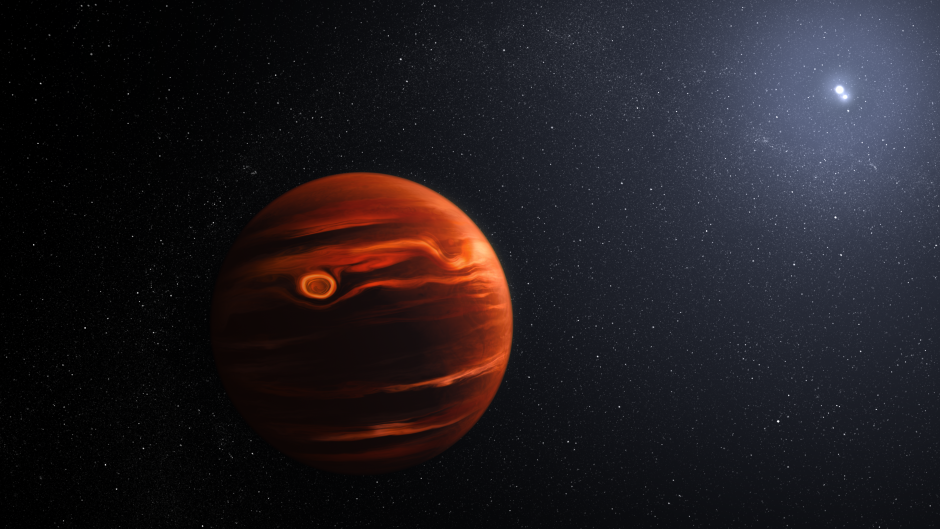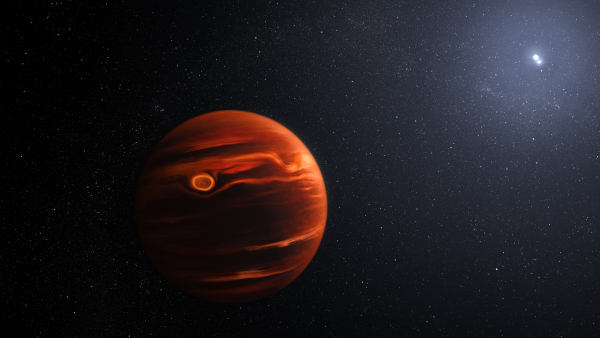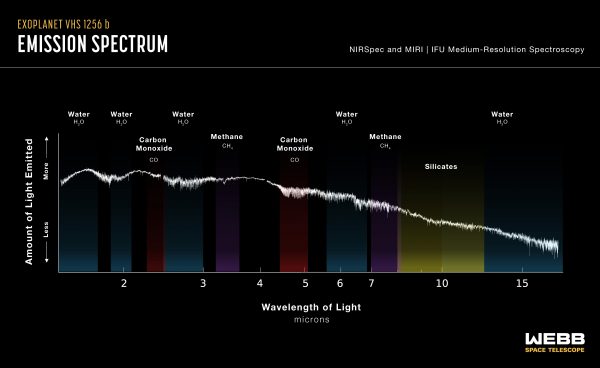Weather report: hot scorching storms of sand on exoplanet VHS 1256 b.

Ever had sand hot whip across your face? That’s a soothing experience compared to the volatile conditions discovered high in the atmosphere of planet VHS 1256 b. Researchers using the James Webb Space Telescope proved that its clouds are made up of silicate particles, ranging from fine specks to small grains. Plus, its near-constant cloud cover is on the move! The international team, which includes Swiss researchers from ETH Zurich and NCCR PlanetS, projects that the silicates swirling in these clouds periodically get too heavy and rain into the depths of the planet’s atmosphere. Webb’s observations also show clear signatures of water, methane and carbon monoxide, and provide evidence for carbon dioxide. This is only the beginning of the team’s research – many more findings are expected as they continue to dig in to Webb’s “downpour” of data.

Artist impression of the swirling clouds identified by the James Webb Space Telescope in the atmosphere of exoplanet VHS 1256 b. The planet is about 40 light-years away and orbits two stars that are locked in their own tight rotation.
Researchers from an international team led by University of Arizona (USA) and the Space Telescope Science Institute (USA), and including researchers from the University of Santa Cruz (USA), University of Edinburgh (Scotland), ETH Zürich (Switzerland) and the NCCR PlanetS (Switzerland), have pinpointed silicate cloud features in a distant planet’s atmosphere observed with the James Webb Space Telescope. The atmosphere is constantly rising, mixing, and moving during its 22-hour day, bringing hotter material up and pushing colder material down. The resulting brightness changes are so dramatic that it is the most variable planetary-mass object known to date. As the brightness is usually what enables astronomers to determine the mass of such directly observed objects, it also means the mass of the planet is not so easy to constrain in the case of this planet. In fact, there is a chance that this planet is so massive that it falls into another category of objects – brown dwarfs – which are halfway between the more massive planets like Jupiter, and the smaller stars existing. The team, led by Brittany Miles of the University of Arizona, also made extraordinarily clear detections of water, methane and carbon monoxide with Webb’s data, and found evidence of carbon dioxide. This is the largest number of molecules ever identified all at once on a planet outside our solar system.
Catalogued as VHS 1256 b, the planet is about 40 light-years away and orbits not one, but two stars over a 10,000-year period. “VHS 1256 b is about four times farther from its stars than Pluto is from our Sun, which makes it a great target for Webb,” Miles said. “That means the planet’s light is not mixed with light from its stars.” Higher up in its atmosphere, where the silicate clouds are churning, temperatures reach a scorching 1,500 degrees Fahrenheit (830 degrees Celsius).
Within those clouds, Webb detected both larger and smaller silicate dust grains, which are shown on a spectrum. “The finer silicate grains in its atmosphere may be more like tiny particles in smoke,” noted co-author Beth Biller of the University of Edinburgh in Scotland. “The larger grains might be more like very hot, very small sand particles.”
VHS 1256 b has low gravity compared to more massive brown dwarfs, which means that its silicate clouds can appear and remain higher in its atmosphere where Webb can detect them. Another reason its skies are so turbulent is the planet’s age. In astronomical terms, it’s quite young. Only 150 million years have passed since it formed – and it will continue to change and cool over billions of years.
In many ways, the team considers these findings to be the first “coins” pulled out of a spectrum that researchers view as a treasure chest of data. To a great extent, they’ve only begun identifying its contents. “We’ve identified silicates, but better understanding which grain sizes and shapes match specific types of clouds is going to take a lot of additional work,” Miles said. “This is not the final word on this planet – it is the beginning of a large-scale modelling effort to fit Webb’s complex data.”
Although all of the features the team observed have been spotted on other planets elsewhere in the Milky Way by other telescopes, other research teams typically identified only one at a time. “No other telescope has identified so many features at once for a single target,” said co-author Andrew Skemer of the University of California, Santa Cruz. “We’re seeing a lot of molecules in a single spectrum from Webb that detail the planet’s dynamic cloud and weather systems.”
The team came to these conclusions by analysing data known as spectra gathered by two instruments aboard Webb, the Near-Infrared Spectrograph (NIRSpec) and the Mid-Infrared Instrument (MIRI). Since the planet orbits at such a great distance from its stars, the researchers were able to observe it directly, rather than taking these data using the transit technique (when the planet passes in front of its star) or a coronagraph (a mask that blocks the light from the star).
There will be plenty more to learn about VHS 1256 b in the months and years to come as this team – and others – continue to sift through Webb’s high-resolution infrared data. “There’s a huge return on a very modest amount of telescope time,” Biller added. “With only a few hours of observations, we have what feels like unending potential for additional discoveries.”
What might become of this planet billions of years from now? Since it’s so far from its stars, it will become colder over time, and its skies may transition from cloudy to clear.
The researchers observed VHS 1256 b as part of Webb’s Early Release Science program, which is designed to help transform the astronomical community’s ability to characterise planets and the disks where they form.
The team’s paper, entitled “The JWST Early Release Science Program for Direct Observations of Exoplanetary Systems II: A 1 to 20 Micron Spectrum of the Planetary-Mass Companion VHS 1256-1257 b,” has been published in The Astrophysical Journal Letters on March 22.
The James Webb Space Telescope is the world’s premier space science observatory. Webb will solve mysteries in our solar system, look beyond to distant worlds around other stars, and probe the mysterious structures and origins of our universe and our place in it. Webb is an international program led by NASA with its partners, ESA (European Space Agency) and the Canadian Space Agency.

The spectrum of VHS 1256 b, observed by the JWST instruments.
Illustration: NASA, ESA, CSA, Joseph Olmsted (STScI)
Science: Brittany Miles (University of Arizona), Sasha Hinkley (University of Exeter), Beth Biller (University of Edinburgh), Andrew Skemer (UC Santa Cruz)
Observing the spectrum of VSH 1256 b.
The research team led by Brittany Miles of the University of Arizona used two instruments known as spectrographs aboard the James Webb Space Telescope, one on the Near Infrared Spectrograph (NIRSpec) and another on the Mid-Infrared Instrument (MIRI) to observe a vast section of near- to mid-infrared light emitted by planet VHS 1256 b. They plotted the light on the spectrum above.
Based on observations of many other exoplanets by several telescopes, the researchers know to look for signatures of clouds in particular areas in the spectrum. Signatures of silicates appears before and after 10 microns, a particular wavelength of infrared light.
There is likely a layer of very small grain silicate clouds higher up in the atmosphere. These silicates are finer, more like smoke particles, and are responsible for creating the plateau near 10 microns. Somewhat larger grain clouds are likely a bit deeper. Some particles in these clouds may be about the size of small grains of sand.
The combined evidence of fluctuations in the planet’s brightness over time and the different cloud layers in the spectrum point to turbulent weather on VHS 1256 b. “These detections reflect that the planet’s cloud patterns change fairly rapidly,” explained Beth Biller of the University of Edinburgh in Scotland. If the researchers were to take more, and longer, observations of the planet, they would see the spectrum shape shift as the locations of the clouds move, reflecting that the clouds are rapidly shifting through the planet’s atmosphere during its 22-hour orbit.
But these aren’t like clouds high in Earth’s atmosphere. These clouds are hot – akin to the temperature of a candle flame. Earth’s upper atmosphere is thin and would feel extremely cold.
The researchers also made extraordinarily clear detections of water, methane and carbon monoxide with Webb, and found evidence of carbon dioxide. It’s too early to tell what this combination of molecules might mean, though, since the data need to be fully modeled. “Webb’s high-resolution data are stressing our existing models,” noted Polychronis Patapis of ETH Zurich in Switzerland. “Existing models can ingest one or two features, but not as many as Webb has shown us of this target.” This is an extraordinarily exciting moment for researchers – it means there is an amazing amount to learn as they revamp models to fit these data.
Webb’s observations of VHS 1256 b highlight many of its technical strengths. Not only do its instruments detect a wide range of near- and mid-infrared light, Webb’s position in space means that the telescope can observe more infrared light than is accessible on Earth – and it captures the details in high resolution. (Earth’s atmosphere filters out some near-infrared and all mid-infrared light.) “Webb has effectively doubled the wavelength range that we’re able to capture,” said Brittany Miles of the University of Arizona, the paper’s lead author. “To top that off, we only needed seven hours to capture the spectrum, which is practically overflowing with details.”
VHS 1256 b is about 40 light-years away in the constellation Corvus. It orbits not one, but two stars, which are tightly orbiting one another. The planet lies about four times farther from its stars than Pluto is from our Sun. Although a single day on this planet is 22 hours long, it takes 10,000 years to complete a single orbit or year.
MIRI was contributed by ESA and NASA, with the instrument designed and built by a consortium of nationally funded European Institutes (the MIRI European Consortium) in partnership with JPL and the University of Arizona.
NIRSpec was built for the European Space Agency (ESA) by a consortium of European companies led by Airbus Defence and Space (ADS) with NASA’s Goddard Space Flight Center providing its detector and micro-shutter subsystems.

